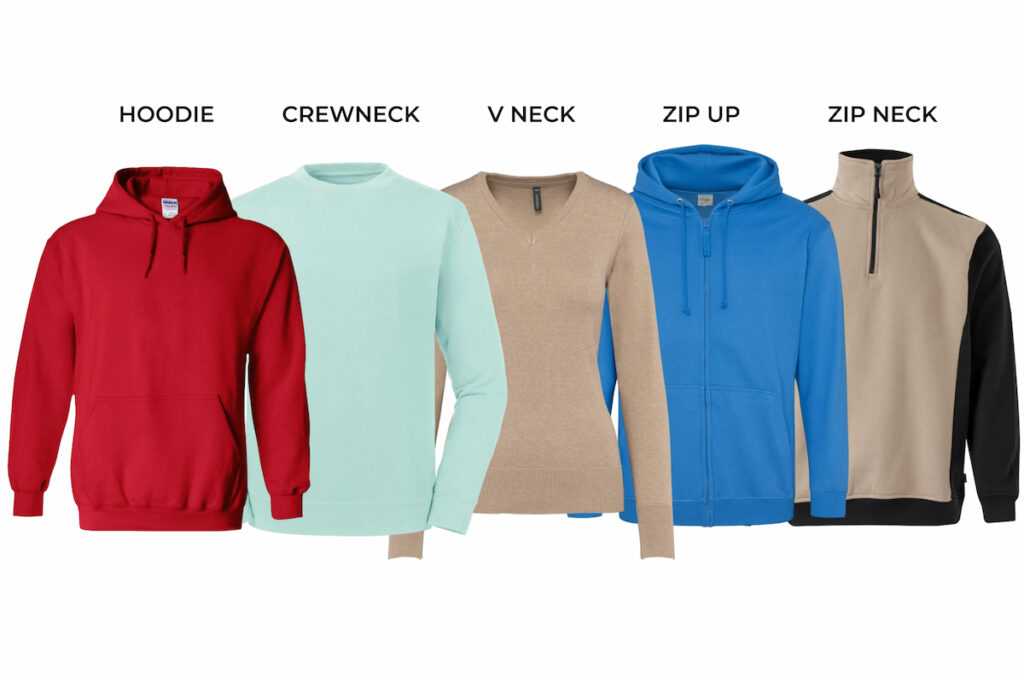Sweaters go by many names, to different people they can be jumpers, sweatshirts, jerseys or pullovers. We all need them, and we all want various types. Comfy ones to wear on the sofa, a light zip-up hoodie for running, and smart sweaters for work, we need room in our wardrobe for all types.
So when you’re shopping for sweaters at Wordans, you can be forgiven for feeling a little daunted at the range of options on offer. We have so many different types of hoodies alone, that it’s best to have a clear idea of exactly what you’re after before you start shopping.
In this guide, we’ll give you a complete breakdown of all the different types and materials available, so that by the time you start looking, you’ll have no problems finding exactly what you need.
Contents
A Brief History of the Sweater

There is debate as to exactly when people started wearing sweaters, as there is a lack of agreement as to whether certain early garments can be described as sweaters. We know that people have been weaving sweater-like garments for centuries. The first common use of what we recognize as sweaters today was among fishermen in the early 19th century. They were knitted by their wives to keep them warm while at sea, and treated with oil to provide water resistance. This was especially common around the island of Jersey in the UK, hence the name jersey.
They gained widespread popularity in the 20th century. Hollywood actors helped make them fashionable, and their practical application saw them used in military uniforms in World War II. By the end of the ‘60s, everyone owned a sweater.
Nowadays, the most popular type of sweater is probably the hoodie. Created by Champion, known as Knickerbocker in those days, it was first used in the 1930s to protect factory workers and athletes from the cold. It gained popularity in the ‘70s when hip-hop emerged, and by the ‘90s could be seen all over the world.
What Are the Different Types of Sweater?
The different names themselves are not the best way to categorize sweaters. Supposedly sweatshirts are cut from larger pieces of fabric, and sweaters are knit to size, but most people use the terms interchangeably. In Britain, a pullover is generally thinner, while jumper can refer to all types, but again, usage mostly depends on personal taste.
When looking for a sweater to buy, the best way to narrow down your search is to think about three categories: hoods/collars, material, and zips/buttons. Below we’ll discuss the different options you have for each, and how they affect your sweater.

Hoods & Collars
The presence or not of a hood dramatically changes the style of the sweater, and helps determine whether or not it would be appropriate for formal wear. Here are your options:
Hoodies
Hoods make hoodies, probably the most popular type of sweater around these days. They’re mostly casual clothing, but as they have become more ubiquitous, you’ll find more companies that see hoodies as appropriate clothing for work.
Most hoods are medium-sized, enough to cover your head with. Some are bigger, perfect to get lost in, or look menacing. Small hoods are for people with small heads, or just for show.
Cowl Neck
Speaking of just for show, cowl neck sweaters are hoodies without the hood. They still have the base of the hood, which gives them the look of a hoodie, and they’re really stylish. They just don’t have the rest of the hood, so aren’t as useful in the rain.
Turtle Neck
Similar to the cowl neck, turtle necks also cover the neck, but are tighter. The result is a much more formal style. While not to everyone’s tastes, they’re firm favorites for some.
Crew Neck
The classic. A round neck with no collar. Crew neck jumpers can be really casual, really formal, and everything in between. It all depends on the material, and the fit. You can also wear one lighter one under a warmer one, if you need to layer up.
V-Neck
V-neck sweaters have a v shape instead of a round collar. You’ll usually find them made with a finer material, with a tighter fit, as they are generally more formal clothing. This is partly because the collar goes great with a shirt underneath, allowing more breathability, and space for a tie if you like.
Sweater Materials
The different types of sweater material can also define the type of sweater, and what you’ll use it for. You don’t want the same material to keep you warm in the winter, and to go running in, and you don’t want to turn up for work in the same material you wear when lying around on the sofa all day. Here are some of the options you have available:

Cotton
The world’s most popular fabric, and for good reason. Cotton is durable, breathable, and natural. Can be used to make all types of clothing, but is particularly common in casual sweatshirts and hoodies. The extra breathability will also keep you smelling fresh in the summer.
Polyester
Polyester is the most popular synthetic fabric. It’s elastic, and resistant to shrinking and color loss. Its lightweight nature makes it an excellent option for sports clothing. Polyester shirts won’t cling to you so much once you start sweating.
Fleece
Made usually from polyester to simulate wool, fleece is resistant to shrinking and doesn’t itch. Perfect for cold weather, fleece is used for really snug sweaters to keep you warm in winter. When it gets really cold, a thinner fleece layer goes nicely under a hoodie.
Wool
The real thing, wool is also found in really warm clothing, especially the famous Christmas sweaters. It also has the advantage of being a natural fiber. Unlike fleece, wool can be woven fine to make beautiful, formal sweaters. Cashmere, from goats rather than sheep, is one of the best-known examples.
Rayon
This silky fabric is made from natural materials. Makes soft, light clothing that feels great on the skin. Rayon is commonly used to make underwear, dresses, and sports clothes.
Velour
A more flexible version of velvet. Velour offers the look of luxury, which can juxtapose nicely with the casual look of a zip-up hoodie. A choice for the bold.
Hybrids
The above materials are often combined into hybrid fabrics, which offer the advantages of multiple materials in the same sweater.
Zips & Buttons
The final choice to make is whether you want buttons, a zip, or neither. This makes a big difference to the look, the formality, how warm your sweater is, and what you’ll use it for. You can choose between:

None
The most versatile option. Having no zip or buttons is great for snug, casual gear, and provides a little extra warmth. Equally popular for baggy, hip-hop style hoodies as luxury cashmere sweaters.
Zip-Up
If hoodies are the most popular type of sweater, zip-up hoodies might be the most popular type of hoodie. Already a practical garment, adding the zip makes it easier to get them on and off, and regulate temperature, it also gives you an extra option style-wise (leaving it open). The extra practicality makes them very popular, it’s not uncommon to bulk buy zip-up hoodies these days.
Cardigan
Cardigans are especially popular for office wear. They give you the option to take them on and off without messing your hair up, and combine beautifully with shirts.
Halfway
Having a zip (zip neck) or buttons that only go halfway down gives you a different look, similar to a v-neck. It also helps you regulate your temperature a little, without losing formality.
Get Picking
Once you’ve decided on each of these things, you’ll have an idea of exactly what type of sweater you’re looking for. Then you’ll be ready to head over to the Sweats & Fleece section at Wordans, and use our filters to find exactly what you need in just a few clicks. You can even personalize your own sweaters with our customization tool. Find more ideas on our Instagram page, @wearewordans.












